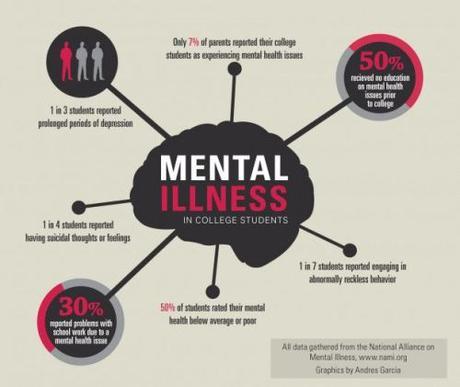
Most people don’t know this, but mentally ill students are an increasing problem on U.S. colleges and universities.
A year before I retired as a professor, I was so spooked by a male student in my evening class that I asked campus police to escort him from the auditorium-style classroom. I actually carried a gun in my brief case to class that evening.
In April 2015, Yahoo reported that 94% of college counseling directors said they’ve seen an increase of students with severe psychological problems, according to the National Survey of College Counseling Centers 2014. Thousands of students were hospitalized for psychiatric conditions by counseling centers that same year.
More and more students are showing up to college with one or more mental illnesses. Today’s college freshmen are significantly more likely to report that they are struggling with depression than even their predecessors of just five years ago, and college counseling centers are straining under the pressure of serving kids with serious mental health issues.
The increasing problem is attributed to a number of factors:
- Medical breakthroughs have made antidepressants and other psychiatric medications widely available, enabling young people with mental illnesses that might have prevented them from going to college a few decades ago, to enroll in colleges and universities.
- Getting accepted to a good college has become harder over the past 15 years, which means stress.
- Indulgent parents: Some college counselors say they see students who are less resilient than earlier generations and unable to cope with failure — from which they have been cushioned by their over-involved parents before they leave home at 18.
- Tulane University president Michael Fitts thinks that the breakdown of religious and family support structures over the past few decades has left some kids feeling lost. The trend toward going to college farther away from home separates students from their social support networks even more.
All of which raises the question of to what extent is a college responsible for its students’ mental health and non-academic life.
College counseling didn’t really exist until the late 1940s, when the federal government created hundreds of counseling centers to help guide a new generation of G.I. Bill-funded students arriving on campus. By the end of the 1960s, about half of all colleges provided some mix of vocational advice and psychological help.
But staffing levels haven’t kept pace with the increase in students who need help. Recently, overwhelmed universities have begun to put limits on how often students can access their mental health services, to cut down on the weeks of waiting for appointments. Some college counseling centers mandate “resiliency training” courses that teach students how to deal with failure and setbacks before they are granted access to a counselor.
“Twenty to 25 years ago, counseling centers tended to see students as long as they needed to be seen,” said Robert Gallagher, who has been surveying the nation’s college counseling directors for decades at the University of Pittsburgh. “As the demand for counseling services increased, and the complexity of the problems that students were bringing to centers grew, many centers began to promote themselves as a ‘session-limited’ service, and much more staff training went into moving students through the therapeutic process more quickly.”
Now, 30% of center directors in Gallagher’s survey say they have limits on how many times students can be seen at their facility. An additional 43% said they promote their centers as a short-term counseling service, even if they don’t explicitly forbid students from using them long-term.
Here are some alarming statistics on the mental health of college students:
Percentage of students who frequently felt depressed:
- 2005: 7%
- 2014: 9.5%
Percentage who felt overwhelmed:
- 2005: 26.8%
- 2014: 34.6%
Percentage who rated their emotional health “above average”:
- 2005: 60.8%
- 2014: 50.7%
According to a 2014 Psychology Today article, rates of anxiety and depression have sky-rocketed in the last few decades. A 2013 survey of college students found that 57% of women and 40% of men reported experiencing episodes of “overwhelming anxiety” in the past year, and 33% of women and 27% of men reported a period in the last year of feeling so depressed it was difficult to function. Studies suggest that between a quarter and a third of students meet criteria for an anxiety or depressive illness during their college experience.
One of the most dangerous aspects of depression and mental health concerns in general is suicide. According to the American College Health Association (ACHA) the suicide rate among young adults, ages 15-24, has tripled since the 1950s and suicide is currently the second most common cause of death among college students. That study also found 9.4% of students reported seriously considering attempted suicide at least once in a 12 month period, a marked increase from several decades ago.
~Éowyn

